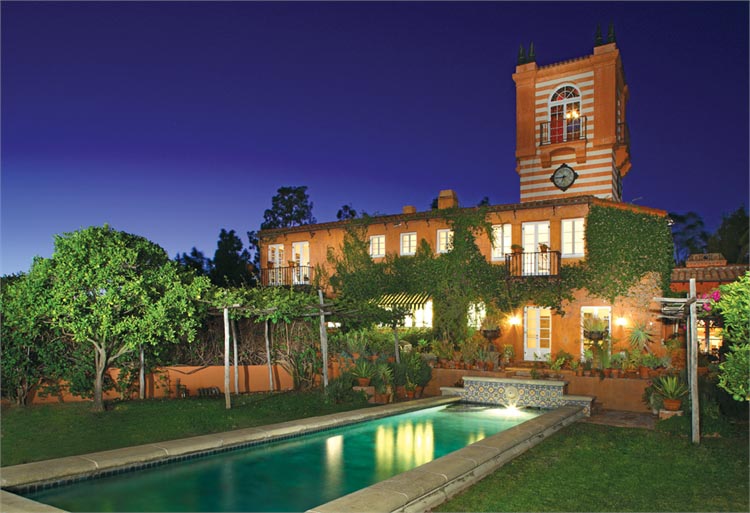Castillo Del Lago
A house which stretches a hundred or more feet from bottom to top is a house with extremes of geography and engineering. Add elements of myth and legend – gangsters, speakeasies, celebrities – to a three-acre hillside location as picturesque and exotic as an Ivory and Merchant film location, and you have a house well suited to attracting attention to itself. Castillo Del Lago, as it has been called for 80 years, is available to buyers able to meet its $10 million price tag. For the rest of us plebeians, its history is available at no charge.
Wealthy from their investment in Signal Hill oil drilling, geologist Patrick Longan and his wife Georgianna commissioned architect John DeLario to design the home in a new hillside subdivision, Hollywoodland, on a new road, the Mulholland Highway, in 1924. The site offered the opportunity for unrivaled views of the very hard to reach mountain reservoir, Lake Hollywood, and a new 50-foot-high sign spelling out the name of the subdivision on the adjacent Mount Lee.
 Photos by Paul Jonason
Photos by Paul Jonason
“It just felt like Italy here, in every aspect,” Christopher Ciccone told photographer Tim Street-Porter when Porter was compiling his “The Los Angeles House” book. Ciccone’s sister Madonna desired the remote location Castillo Del Lago provides, and bought it in 1993.
To design a house which would “fit” called for the talents of an architect who was also an engineer, and DeLario had already been employed as a draftsman by a leader in both fields, Albert C. Martin. According to Bob Crane’s book “Hollywood Land and Legend,” $100,000 was spent strictly to grade the site and to erect a ramp that would bring materials and workers to its crags and steep slopes. The finished house is a high art example of why it seemed appropriate in the 1920s to look at the terrain and climate of Los Angeles and conclude that the Mediterranean was the best architectural inspiration. Its high quality of construction in Ferro cement could withstand the ravages of time.
The Longans enjoyed the solitude and beauty of their $250,000 nine-level home for a few years before Mrs. Longan’s death prompted Mr. Longan to sell it. The next resident of Castillo Del Lago was, according to Crane, the gangster Bugsy Siegel. The mob leader found its wealth of rooms perfect for illicit activities. Gambling and night life followed and so did the police, who staked out the situation from another house on the hill. If you look hard enough, you can see holes in the woodwork of the entry hall which resulted from flying bullets.
The Hollywoodland sign meanwhile was advertising a subdivision which was not selling. The Depression ruined the fortunes of architect DeLario, and when he died in 1950, his body was placed in an unmarked grave at Forest Lawn Glendale. His best known design, Castillo Del Lago, was unoccupied. Vandals set fire to the master suite but responding fire crews could not find the remote driveway far from either Durand or Mulholland Drives.
During the 1970s, the fortunes of Castillo Del Lago improved. The Donald Willfongs managed to find some of its original furnishings and fixtures on sale, and returned them to the house. Next James Lefleur took title and constructed a prominent four-sided tower, one more opportunity for long-distance views.
With her fortunes as a celebrity assured, Madonna purchased the house in 1993 and lived there while filming “Evita.” Her brother took over as contractor, and saw to the painting of Castillo Del Lago in stripes of oxblood red and mustard paint.
Many in Hollywoodland were not impressed and the controversy which tends to follow Madonna followed her once again. After an intruder tried scaling the hillside and was shot by a bodyguard, Madonna sold the house to film maker and director Joe Pytka. His eye for detail has led to a 15-year-long renovation which seems to have transformed every inch of the place.
Eight air conditioning units were brought in by helicopter and installed on the mountainside. The master bath is a shrine to Moroccan tile. The kitchen’s entire white scheme is soothing, down to the Carrara marble of the countertops. Gardens appear whenever one looks out a window on the main living area floor. There is a $250,000 sound system, new clocks in the renovated tower, wine cellars, and a wood paneled library. Ebony wood floors in the living room provide an informal quality, a quality which the Wall Street Journal is calling “Rough Luxe” for an effort by some decorators to make interiors less stylized to reflect the challenging economic times.
“It is finally about as perfect as it will ever be,” Pytka believes.
The house has seven baths, seven bedrooms, a spiral staircase covering six of the levels, and an elevator stopping at the other three. There is a swimming pool and a gym.
The privacy and the 300-degree views are unrivalled, especially of the sign once meant to sell the subdivision and now selling all of Southern California to the world. DH